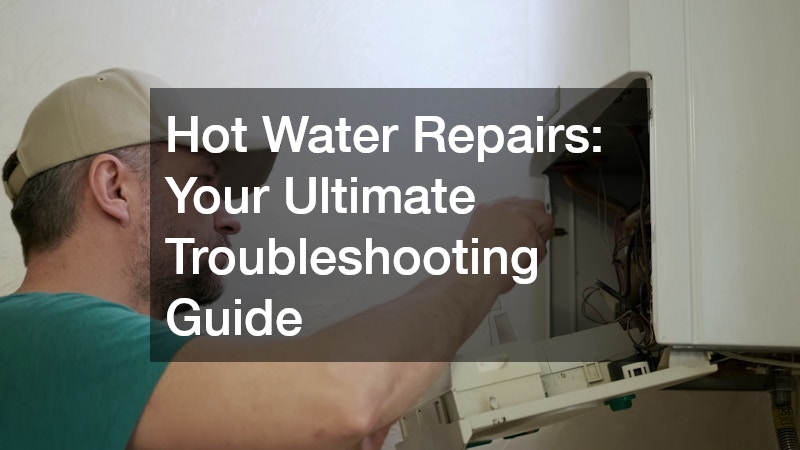A reliable hot water system is essential for everyday comfort, especially in Australian homes where chilly mornings and cooler seasons make a warm shower a necessity. However, like any household appliance, hot water systems can encounter issues over time, leaving you with cold showers or inefficient heating. Knowing the basics of hot water repairs can save you time, stress and money, especially when you spot the early warning signs of a malfunction. This guide will walk you through the most common problems, how to troubleshoot them safely and when it’s time to call a professional.
Understanding Common Hot Water Problems
Hot water systems can be electric, gas, or solar-powered, but all share similar components such as a heating element, thermostat and tank. One of the most common issues that trigger hot water repairs is the complete absence of hot water. This may be due to a faulty heating element or thermostat failure. For electric systems, the element heats the water inside the tank and if it burns out or becomes covered in sediment, the water will fail to warm properly. Gas systems rely on a pilot light or ignition system to heat the water and if the pilot light goes out, your water won’t heat up.
Another typical problem is water that is hot one minute and cold the next. This inconsistency often results from a faulty thermostat that fails to regulate the water temperature properly. Sediment build-up inside the tank can also cause this issue by insulating the heating element and reducing its efficiency. Leaks from the tank or pipes are also a significant concern. Not only do leaks waste water and increase bills, but they can cause damage to your home if left unchecked.
Troubleshooting Hot Water Repairs Safely
Before attempting any repairs, ensure you switch off the power supply to the hot water system at the mains or turn off the gas supply if it is gas-powered. Safety is paramount as electrical components and gas fittings can pose hazards if handled improperly. When troubleshooting, start with the simplest potential cause. For example, check if the pilot light on a gas system is lit. If it has gone out, relighting it might restore hot water immediately. Consult the manufacturer’s instructions or contact a professional if you’re unsure how to do this safely.
For electric systems, you can test the thermostat and heating element using a multimeter to check for continuity, but this requires some technical knowledge. If you are not comfortable with electrical work, it is best to call a licensed plumber or electrician. A visible leak should never be ignored. Inspect the area around your hot water system for puddles or dampness. Leaks from the pressure relief valve or tank indicate the need for urgent repairs. Small leaks can sometimes be traced to loose fittings or corroded pipes, which may be fixed by tightening or replacing parts. However, leaks from the tank itself generally mean the entire unit needs replacement.
When to Call a Professional for Hot Water Repairs
While minor maintenance and simple troubleshooting can be done by homeowners, hot water repairs often require professional skills. Gas hot water systems especially must be serviced by licensed technicians due to safety regulations and the complexity of gas fittings. Electrical repairs to the heating elements or thermostats also demand professional handling to avoid risk of shock or further damage.
If you notice persistent leaks, irregular water temperature, or if your hot water system is over 10 years old and frequently requires attention, it is advisable to call a professional plumber. They can diagnose underlying issues, replace faulty parts and advise on whether repairing or replacing the unit is more cost-effective. Attempting to fix significant problems yourself can lead to incomplete repairs or worsen the issue.
Tips for Maintaining Your Hot Water System
Maintaining your hot water system properly can reduce the need for costly hot water repairs. Flushing the tank at least once a year helps remove sediment that causes noises and reduces heating efficiency. For electric systems, regularly checking and replacing the anode rod will protect the tank from corrosion. Gas systems benefit from regular inspection of the burner and pilot light to ensure they are clean and functioning correctly.
Another useful tip is to set your thermostat to a temperature around 60 degrees Celsius. This temperature is hot enough to prevent bacterial growth but not so hot that it wastes energy or poses a scalding risk. Insulating the hot water pipes and the tank itself also improves efficiency and lowers energy bills.
Hot water repairs are an inevitable part of home maintenance, but many common problems can be identified and sometimes fixed before they escalate. Understanding your system, performing simple troubleshooting safely and recognising when to call a professional can save you significant time and expense. Whether your system is electric, gas, or solar, routine care and prompt attention to issues will keep your showers warm and your household running smoothly. Remember, the right balance of DIY care and professional service is key to extending the life of your hot water system and avoiding costly replacements.
By following this ultimate troubleshooting guide, you will be well equipped to tackle common hot water repairs with confidence, ensuring you never have to endure the discomfort of cold water when you need it most.

